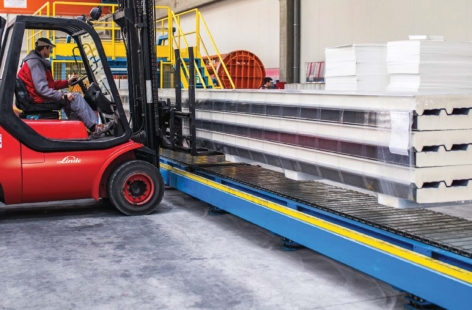Storing & Lifting Instructions
Storing & Lifting Instructions
PACKING
Sandwich panels are being delivered on stacks. To ensure protection of the edges of the panel in loading and unloading activities carried out by crane with lifting belts, stacks need to be reinforced at the bottom and at the top with protective angular elements that accompany the panels in each expedition.

TRANSPORT
The sandwich panels can be transported only by roadworthy trucks.
Load-carrying surfaces must be clean. No nails or other sharp objects can protrude from the truck bed or its walls. Protruding objects have to be properly secured to avoid damage to the panels.
The vehicle has to be long enough to ensure complete support coverage for the loaded package. The package is allowed to protrude no more than 1.5 m out of the truck bed. The recommendation loading space width ranges is about 2500 mm, whereas the maximum traveling speed cannot exceed 70 km/h.
The vehicle to carry the panels should be equipped with cargo straps to ensure the cargo on the vehicle bed. Number of the straps depends upon the panels length; the straps should be spaced approximately every 2 m. In case of flashing packages are being transported with the panel packages, they should be fastened separately.
The panels should be checked for defects upon delivery. Claims must be specified in the consignment note and accompanying documents, that the recipient or his attorney has signed, and be notified immediately in writing to the competent office outlets according to the sale contract.
UNLOADING
The unloading of the panels should proceed in a manner shown in the drawing below. Разтоварването на панелите трябва да става по начин показан на схемата по-долу (Unloading with slings can result in damage to the panels / stacks of panels)! If the stack is long particular attention should be paid to the bending and deflection. These problems are eliminated with the use of a crane beams and sleepers.

Stacks up to 6m can be raised and forklifts.
Packets with length of 6m to 13,5 m should be lifted by crane or with forklift for long panels. To ensure protection of the edges of the panel in loading and unloading activities carried out by crane with lifting belts, stacks need to be reinforced at the bottom and at the top with protective angular elements that accompany the panels in each expedition.
STORAGE CONSIDERATIONS
Do not keep the package of panels at a job site or warehouse more than 3 months. To protect the package from the collected water at the base put wooden or polystyrene block trough the long side with minimum height 100 mm. Stacking yard must be open to air circulation.
If the package of panels at a jobsite cannot be stored inside, be sure to wrap the packages with polyethylene covering. The covering needs to be applied in a manner that does not allow water to accumulate in the package.
At a minimum, cover the packages with a tarp! Keep the tarp covering open at the bottom so that water can flow away freely and so that the packages can have freely airflow to allow the packages to dry if for some reason condensation does occur.
Put the packages with 5% slope, in order to prevent the water collection between the panels! Do not store more than three packages one on top of another and place spacers or board between them!

WEATHER CONDITIONS
The following weather conditions are of critical importance for assembly of sandwich panels.
Due to the relatively low weight-surfaces ration of the panels, the wind speed should not exceed 9 m/s. The panels should not be installed during snow and rain falls or during a dense fog. The panel assembly should be stopped when the visibility reduces at dusk and there is no artificial light provided.
Sealing operations should not be performed in the ambient temperature above 4 °C.
PREPARING FOR INSTALATION WORK
Before attempting to install the sandwich panels proceed as follow.
Check the structure for compliance with design specifications and construction accuracy.
Make sure the spacing of purlins, columns and spandrel beams is consistent with the guidelines contained in the static load tables.
Make sure the purlins/ columns/ spandrel beams surfaces form a plane.
Prepare necessary tools for assembly of panels.
Proper structure preparation will facilitate the assembly, and result in faultless performance of fasteners and joints, ensuring esthetical building finish.
INSTALATION
In order to prevent the high-quality panels from being damaged, they must be handled with care. It is recommended that clean gloves are worn.
Usually the panel edges have a type of burr from the searing operation and the paint film can be scratched trough to the zinc containing coating when panels are slid across one another. At any location where the paint is compromised, the metallic coating begins to corrode more rapidly and life of the prepainted panel is adversely affected.
Do not sweep the panels from the package in the manner shown in the drawing below. Pulling and dragging the panels can cause scratches. Grasp both sides and lift by pushing in the lateral direction!

When removing single panels from a package, make sure that any distortion, bending and localized loads on the panels are avoided! The panels should be transported vertically!





